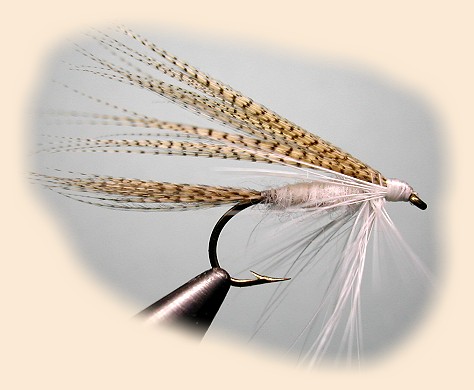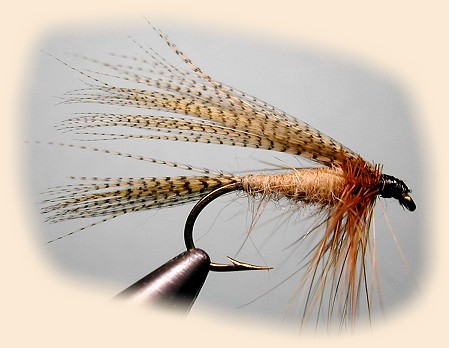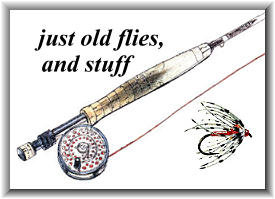When the lightning bolt of fame, if not fortune,
struck Dan Cahill of Port Jervis, N.Y. back in 1884,
it only left him a footnote in the annals of fly
fishing history. I guess that's enough if the story
is still being told 120 years later.
When Dan wasn't fishing or tying flies he was a brakeman
on the old Erie and Lackawana Railroad. One steamy, hot
summer day in the Catskills, Dan was working a Lackawana
freight north of Port Jervis. On board were can of big
brood stock rainbow trout, presumably headed for the
Caledonia fish hatchery in upstate New York. When his
own train was blocked by a derailed work train, Cahill
knew the trout would never make it in the mid-summer heat.
Taking action quickly, Dan talked his fellow crew members
into helping him carry the heavy can of trout back to
Calicoon Creek and dump them. It was almost a mile,
but the big rainbows not only survived the ordeal, they
flourished in the little Catskill stream, and that
unscheduled stocking and their offspring eventually
spread throughout the Delaware watershed.
Rainbows were later stocked in the Esopus and other
Catskill streams of the Hudson River drainage. To
this day their ancestors provide the finest rainbow
trout fishing in the east.
Edward Ringwood Hewitt, the famous fishing writer and
fish culturist on the Neversink River, was a fishing
companion of Cahill during that period. As a consummate
story teller, Hewitt was fond of telling the rainbow
trout story to his friends and that gave old Dan
Cahill a permanent place in fly fishing history.
Cahill's real claim to fame, though, was his creation
of the Cahill fly. Ray Bergman author of the best
selling Trout in 1938, said of the Light Cahill,
"If it was necessary to confine my assortment of
flies to only two or three, this would be one of
them." Strong words from the man who wrote the
definitive work on trout
up until that time.
"It is an eastern pattern," Bergman added, "particularly
effective in the Catskill waters and similar eastern
mountain streams." Be he further added that it served
him well in Michigan in the Mid-west and Wyoming and
California in the Far West.
Art Flick, of Westkill N.Y., in his famous little
Stream Guide to Natural and Their Imitations,
said of the Light Cahill, "To this date I have never
met a fisherman who had fished any stream where trout
could not be taken on this fly. It is doubtful if any
fly compares with it in popularity, especially in the
East."
The Cahill regular, or Dark Cahill as it is most often
tied, was probably the fly that Dan originally created.
It was a "particularly killing fly" for brook trout
according to Bergman.
The brown trout was still several years from being
introduced in this country and the accidental rainbow
stock had just been set in motion. It appears Dan
Cahill had created and fished this fly for his native
brook trout that thrived in the Catskills.
History credits Theodore Gordon with starting the
Cahill flies on their journey to become one of the
most prominent wet and dry fly combination in history.
Dan Cahill, himself, is credited with creating a
lighter version of the fly, but apparently the
split between the dark and light version originated
in Gordon's vise.
William Chandler, who tied for the venerable William
Mills and Sons of New York City, tied an even lighter
version that was to remain the standard dressing for
decades. Not to be denied, Rube Cross, another famous
Catskill fly tier, got into the act by tying a pattern
with an almost white body.
Presently, the Dark Cahill remains almost like the
original, while its more famous partner keeps changing
and evolving into mixtures of cream, yellow and white.
The Cahills imitate a family of mayflies, Stenonema.
They begin hatching in late May and continue through
June, while similar light flies emerge sporadically
throughout the summer. As one write put it, "they
have a long shelf life." The Cahill is "hatch specific"
and the naturals emerge from late afternoon through
the evening. On overcast days there may be an
occasional morning hatch.
For the last several years I have used the Cahills,
both dark and light, wet and dry, almost exclusively
for my brook trout fishing here in Maine; although I
must admit, I use the wet fly more than the dry.
Bergman was right. It is a "killing fly" and it has
a century's worth of history and testimonial to back
up that claim. History also shows that Dan Cahill
had to share the credit for his popular fly's creation
with other, more famous, tiers of the time. On the
other hand, he did come away with one thing the
others didn't. It bears "his" name.

Light Cahill Wet
Tied by Gerald E. Wolfe
Hook: Mustad 3904 or TMC 3761; 10-16.
Thread: White or Cream 6/0.
Tail: Lemon wood duck flank fibers.
Body: Cream to white rabbit dubbing.
Hackle: Cream to white, hen or rooster saddle.
Wing: Lemon wood duck flank fibers.

Dark Cahill Wet
Tied by Gerald E. Wolfe
Hook: Mustad 3904 or TMC 3761; 10-16.
Thread: Black 6/0.
Tail: Lemon wood duck flank fibers.
Body: Tan rabbit or muskrat dubbing.
Hackle: Dark ginger hen.
Wing: Lemon wood duck flank fibers.
~ Gerald E. Wolfe (RW)
|



